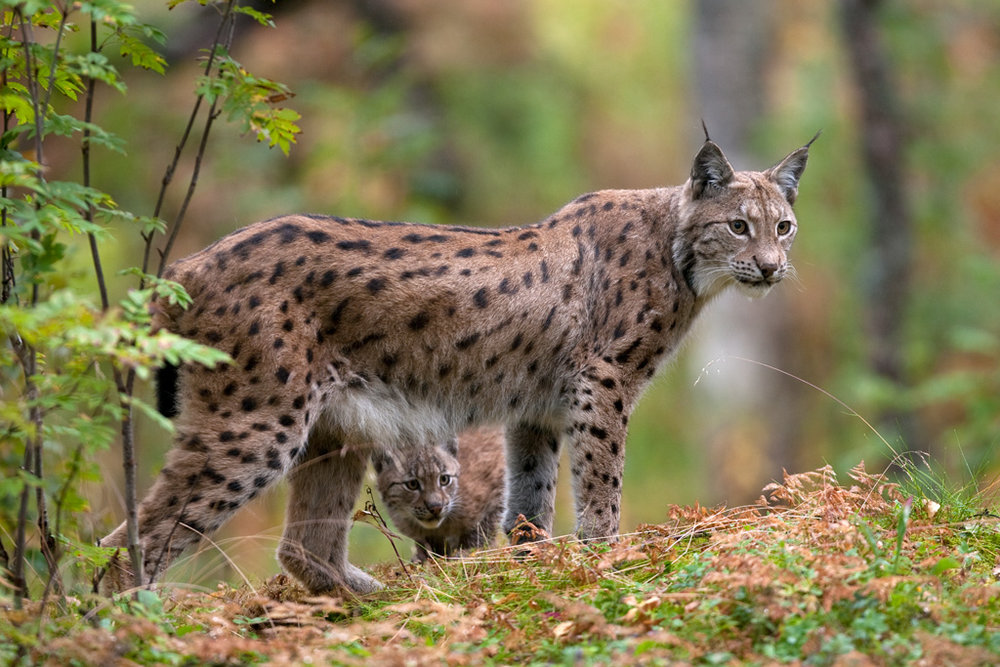Reintroduction is not just a dream

The Eurasian lynx (Lynx lynx) is now listed as Least Concern (LC) by International Union for Conservation of Nature and Natural Resources (IUCN).
The Eurasian Lynx has a very broad distribution and occurs along forested mountain ranges in southeastern and Central Europe and from northern and eastern Europe through the Boreal forests of Russia, down into Central Asia and the Tibetan plateau.
Currently six subspecies of the Eurasian Lynx are proposed. Eurasian lynx or (Lynx lynx dinniki) subspecies also occur throughout the Caspian Forests of Alborz range and in northwestern Iran, usually in the highest elevations. Eurasian lynx also recorded in the Zagros range in Dena Protected Area.
But in Europe, it was probably absent from some of the larger islands such as Ireland and Sicily and from countries with few forests. In fact, the Eurasian lynx was almost extinct around 1900, but has been slowly recovering in Europe since then. Larger populations persisted in Fennoscandia, the Baltic States, and European Russia. Lynx have been released in several countries of Europe in an effort to bring back this elusive predator, including in Switzerland, Slovenia, Italy, Czech Republic, Austria, Germany and France. It is now well established in Switzerland and the Czech Republic, but they do not live in large parts of their former range in Germany.
Where are the best habitats?
Take a look to the following map, red areas show permanent and grey areas are sporadic current ranges of Eurasian lynx at Europe. At this map, you can see two question marks which shows undetermined areas and six blue signs that refers to possible reintroduction areas. Do you know which regions of Germany are suitable for lynx reintroduction?
The simplest way to answer this question is to describe the present lynx habitat in Switzerland and the Czech Republic and look for similar habitats in Germany. German ecologists found that the best lynx habitat contains connected forest areas within a radius of 5 km, the size of a female lynx home range in Switzerland. By analyzing satellite images of Germany, the researchers concluded that about 24,000 km2 (8% of the country’s land area) is suitable for lynx reintroduction. That amount of habitat could support about 370 lynx.
What is the habitat suitability model?
From the ecological viewpoint, questions like this will be answer by habitat suitability models. We know, if the suitability of a habitat for a particular species can be defined, it should be possible to predict the average density the species could reach in that habitat.
With this knowledge, we should be able to manage endangered and economically important species better. For example, before American reintroduce species such as the wolves into an area, they need to know if the area still contains suitable habitat in spite of changes human have made to the area.
Defining habitat suitability has been a goal of wildlife and fisheries management agencies for the past century and has led to the creation of many habitat suitable models. A habitat suitability model is a mathematical model that explains quantitatively how specific ecological factors affect the abundance of a species. By habitat suitability models, ecologists used base on the assumption that species live only in suitable habitats.
However, this does not necessarily mean that a habitat is unsuitable for a species just because that species is not presently found there. If the distribution of a species is limited by dispersal, there may be large areas of suitable habitat that are not occupied. Scientists. At 2002 assumed that key potential sites for reintroduction lynx in Germany include the Harz Forest, the Black Forest and the Alps. Black rectangles in the map enclose areas where lynx have been studied intensively by European ecologists.
Successful reintroduction to the wild
Conservationists have been releasing zoo-bred Eurasian lynx in Germany's Harz Mountains in the past decade with the goal of returning them to their natural habitat. But what was the reason of declining population in Germany?
The Eurasian lynx population in Germany declined because of hunting by hunters who threatened their farm animals and local game. Eurasian lynx, disappeared from the region nearly 200 years ago as mentioned before. Most of the 7,000 to 8,000 Eurasian lynx now living in Europe are found in the Nordic countries, with scattered populations in western and central Europe. The plan of reintroducing Eurasian lynx to the nature of Germany still meets with initial resistance by some local farmers and individual hunters, meanwhile most locals are celebrating the return of Eurasian lynx because they are cashing in on lynx appeal to tourists.
Eurasian lynx is not so shy in front of the camera. But seeing a lynx in the wild is extremely difficult, although numerous sightings are reported within the Harz Mountains each year, and can be tricky even at the wooded enclosure in the Harz. Spiegel online in the first day of October, 2010 had an interview by Andreas Kinser, a forestry expert with the German Wildlife Federation. He said at that time: “The lynx population in the Harz Mountains is between some 50 to 60 animals. In Bavaria, the estimates run from 50 to 100, according to officials with the Bavarian National Park.”
The recent studies show that the Eurasian lynx living permanently in 11 population groups across 23 European countries, of which only five were native populations, indicating the success of reintroduction efforts.
Leave a Comment